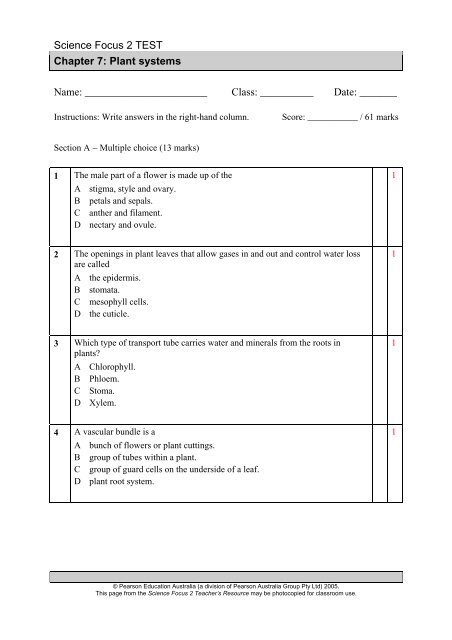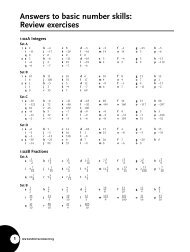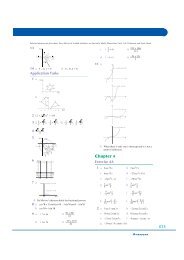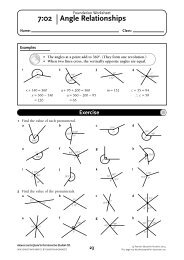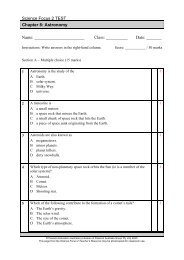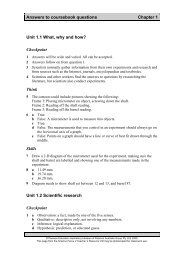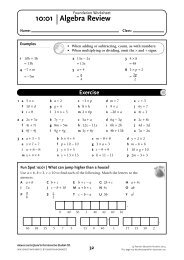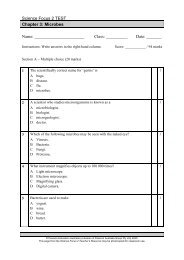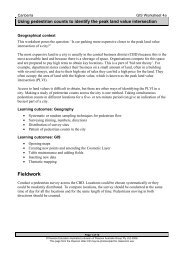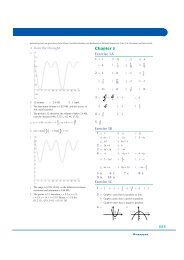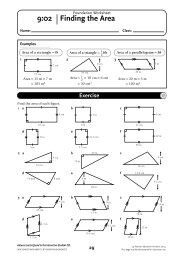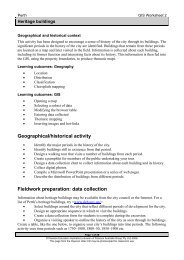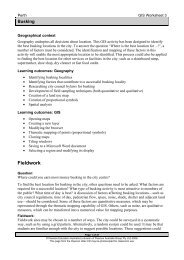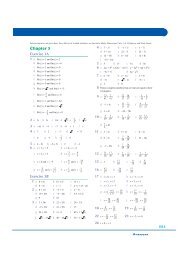Science Focus 2 TEST Chapter 7 - Pearson Australia Media ...
Science Focus 2 TEST Chapter 7 - Pearson Australia Media ...
Science Focus 2 TEST Chapter 7 - Pearson Australia Media ...
You also want an ePaper? Increase the reach of your titles
YUMPU automatically turns print PDFs into web optimized ePapers that Google loves.
<strong>Science</strong> <strong>Focus</strong> 2 <strong>TEST</strong><br />
<strong>Chapter</strong> 7: Plant systems<br />
Name: _______________________ Class: __________ Date: _______<br />
Instructions: Write answers in the right-hand column.<br />
Score: ___________ / 61 marks<br />
Section A − Multiple choice (13 marks)<br />
1 The male part of a flower is made up of the<br />
A stigma, style and ovary.<br />
B petals and sepals.<br />
C anther and filament.<br />
D nectary and ovule.<br />
1<br />
2 The openings in plant leaves that allow gases in and out and control water loss<br />
are called<br />
A the epidermis.<br />
B stomata.<br />
C mesophyll cells.<br />
D the cuticle.<br />
1<br />
3 Which type of transport tube carries water and minerals from the roots in<br />
plants?<br />
A Chlorophyll.<br />
B Phloem.<br />
C Stoma.<br />
D Xylem.<br />
1<br />
4 A vascular bundle is a<br />
A bunch of flowers or plant cuttings.<br />
B group of tubes within a plant.<br />
C group of guard cells on the underside of a leaf.<br />
D plant root system.<br />
1<br />
© <strong>Pearson</strong> Education <strong>Australia</strong> (a division of <strong>Pearson</strong> <strong>Australia</strong> Group Pty Ltd) 2005.<br />
This page from the <strong>Science</strong> <strong>Focus</strong> 2 Teacher’s Resource may be photocopied for classroom use.
<strong>Science</strong> <strong>Focus</strong> 2 <strong>TEST</strong><br />
<strong>Chapter</strong> 7: Plant systems<br />
5 In which of these plant leaf cells is the maximum rate of photosynthesis<br />
expected to occur?<br />
A Epidermal cells.<br />
B Palisade cells.<br />
C Xylem cells.<br />
D Mesophyll cells.<br />
1<br />
6 If carbon dioxide, water and chlorophyll are placed in a test tube in the sunlight<br />
A glucose and bubbles of oxygen will be produced immediately.<br />
B glucose and bubbles of oxygen will be produced, but only after a long<br />
period of time.<br />
C no reaction will occur because one reactant is missing.<br />
D no reaction will occur because necessary enzymes are missing.<br />
1<br />
7 Photosynthesis may be considered a two-stage process. Which of the following<br />
occurs during stage 1?<br />
A Energy is released by chlorophyll molecules.<br />
B Energy is trapped by chlorophyll molecules.<br />
C Carbon dioxide is released.<br />
D Starch molecules are made.<br />
1<br />
8 An experiment was conducted using the set-up shown below.<br />
1<br />
The volume of gas collected in the test tube after 2 hours would not be affected<br />
by the<br />
A size of the test tube.<br />
B mass of plant used.<br />
C intensity of the light source.<br />
D temperature of the solution.<br />
© <strong>Pearson</strong> Education <strong>Australia</strong> (a division of <strong>Pearson</strong> <strong>Australia</strong> Group Pty Ltd) 2005.<br />
This page from the <strong>Science</strong> <strong>Focus</strong> 2 Teacher’s Resource may be photocopied for classroom use.
<strong>Science</strong> <strong>Focus</strong> 2 <strong>TEST</strong><br />
<strong>Chapter</strong> 7: Plant systems<br />
9 At night the starch in leaves is reconverted to glucose. This is called<br />
A photosynthesis.<br />
B Benzyme release.<br />
C destarching.<br />
D respiration.<br />
1<br />
10 The process of using oxygen to release energy from food is called<br />
A photosynthesis.<br />
B respiration.<br />
C breathing.<br />
D elimination.<br />
1<br />
11 Respiration is a chemical reaction which<br />
A occurs only in the body cells of animals.<br />
B always has oxygen as a reactant.<br />
C involves a sequence of reactions.<br />
D is endothermic (absorbs energy).<br />
1<br />
12 Which colour of light is not absorbed by chlorophyll?<br />
A Green.<br />
B Red.<br />
C Blue.<br />
D Orange.<br />
1<br />
© <strong>Pearson</strong> Education <strong>Australia</strong> (a division of <strong>Pearson</strong> <strong>Australia</strong> Group Pty Ltd) 2005.<br />
This page from the <strong>Science</strong> <strong>Focus</strong> 2 Teacher’s Resource may be photocopied for classroom use.
<strong>Science</strong> <strong>Focus</strong> 2 <strong>TEST</strong><br />
<strong>Chapter</strong> 7: Plant systems<br />
13 The graph below shows the amount of oxygen produced by a plant as light<br />
intensity was increased under two different sets of conditions.<br />
1<br />
Which of the following would explain the difference between graphs X and Y?<br />
A Graph X was obtained with the plant in orange light, graph Y with the plant<br />
in red light.<br />
B Graph X was obtained with the plant at a higher temperature than for graph<br />
Y.<br />
C Graph X was obtained with the plant in a higher concentration of carbon<br />
dioxide than for graph Y.<br />
D Graph X was obtained using a larger mass of plant than for graph Y.<br />
Section B − Written answers (48 marks)<br />
1 Label the following parts of a plant<br />
stem cross-section using the terms<br />
below.<br />
4<br />
xylem, phloem, cambium, vascular<br />
bundle<br />
© <strong>Pearson</strong> Education <strong>Australia</strong> (a division of <strong>Pearson</strong> <strong>Australia</strong> Group Pty Ltd) 2005.<br />
This page from the <strong>Science</strong> <strong>Focus</strong> 2 Teacher’s Resource may be photocopied for classroom use.
<strong>Science</strong> <strong>Focus</strong> 2 <strong>TEST</strong><br />
<strong>Chapter</strong> 7: Plant systems<br />
2 Identify two functions of<br />
a the roots.<br />
b the stem.<br />
4<br />
3 Flowering plants may either be selfpollinated<br />
or cross-pollinated.<br />
a Define cross-pollination.<br />
b Propose two ways in which<br />
cross-pollination can be made to<br />
occur.<br />
4<br />
4 A particular flower has its stigma placed<br />
higher than its anthers. Predict whether<br />
this flower could be self-pollinated.<br />
Explain your answer.<br />
2<br />
© <strong>Pearson</strong> Education <strong>Australia</strong> (a division of <strong>Pearson</strong> <strong>Australia</strong> Group Pty Ltd) 2005.<br />
This page from the <strong>Science</strong> <strong>Focus</strong> 2 Teacher’s Resource may be photocopied for classroom use.
<strong>Science</strong> <strong>Focus</strong> 2 <strong>TEST</strong><br />
<strong>Chapter</strong> 7: Plant systems<br />
5 The diagram below shows a section<br />
through a plant leaf.<br />
5<br />
Identify which label (1 to 8) represents<br />
a an epidermal cell.<br />
b a palisade cell.<br />
c a xylem vessel.<br />
d a chloroplast.<br />
e a stoma cell.<br />
6 Propose explanations for<br />
a plants in the desert growing very<br />
slowly.<br />
b plants not being found in the<br />
ocean at depths greater than<br />
300 m.<br />
4<br />
© <strong>Pearson</strong> Education <strong>Australia</strong> (a division of <strong>Pearson</strong> <strong>Australia</strong> Group Pty Ltd) 2005.<br />
This page from the <strong>Science</strong> <strong>Focus</strong> 2 Teacher’s Resource may be photocopied for classroom use.
<strong>Science</strong> <strong>Focus</strong> 2 <strong>TEST</strong><br />
<strong>Chapter</strong> 7: Plant systems<br />
7 a Write a chemical equation for the<br />
process of photosynthesis.<br />
b Identify two other requirements<br />
(apart from the reactants) for<br />
photosynthesis to occur.<br />
c Define the reaction as either<br />
exothermic or endothermic.<br />
4<br />
8 Identify the plant cell structures in<br />
which the following processes occur.<br />
a Stage 1 of respiration.<br />
b Stage 2 of respiration.<br />
c Photosynthesis.<br />
9 Identify three ways in which the<br />
glucose produced during photosynthesis<br />
may be used by a plant.<br />
3<br />
3<br />
© <strong>Pearson</strong> Education <strong>Australia</strong> (a division of <strong>Pearson</strong> <strong>Australia</strong> Group Pty Ltd) 2005.<br />
This page from the <strong>Science</strong> <strong>Focus</strong> 2 Teacher’s Resource may be photocopied for classroom use.
<strong>Science</strong> <strong>Focus</strong> 2 <strong>TEST</strong><br />
<strong>Chapter</strong> 7: Plant systems<br />
10 The graph below shows the effect of<br />
light intensity on the rate of<br />
photosynthesis.<br />
4<br />
Explain<br />
a why the rate increases in the first<br />
section (I) of the graph.<br />
b why the rate does not increase in<br />
the second section (II) of the<br />
graph.<br />
11 An experiment was conducted using the<br />
flasks shown below. All flasks<br />
contained water, were at the same<br />
temperature and were in sunlight.<br />
4<br />
After two hours the carbon dioxide level<br />
in each flask was measured.<br />
a Identify the flask (A–D) in<br />
which the carbon dioxide level<br />
would be lowest after two hours.<br />
b Explain how you arrived at your<br />
choice in part (a).<br />
© <strong>Pearson</strong> Education <strong>Australia</strong> (a division of <strong>Pearson</strong> <strong>Australia</strong> Group Pty Ltd) 2005.<br />
This page from the <strong>Science</strong> <strong>Focus</strong> 2 Teacher’s Resource may be photocopied for classroom use.
<strong>Science</strong> <strong>Focus</strong> 2 <strong>TEST</strong><br />
<strong>Chapter</strong> 7: Plant systems<br />
12 Which colour of light is strongly<br />
absorbed by<br />
a water?<br />
b green algae?<br />
c red algae?<br />
3<br />
13 a Write a chemical word equation<br />
for the process of aerobic<br />
respiration.<br />
b Does this reaction absorb or<br />
release energy?<br />
c What does the word ‘aerobic’<br />
mean?<br />
4<br />
© <strong>Pearson</strong> Education <strong>Australia</strong> (a division of <strong>Pearson</strong> <strong>Australia</strong> Group Pty Ltd) 2005.<br />
This page from the <strong>Science</strong> <strong>Focus</strong> 2 Teacher’s Resource may be photocopied for classroom use.


